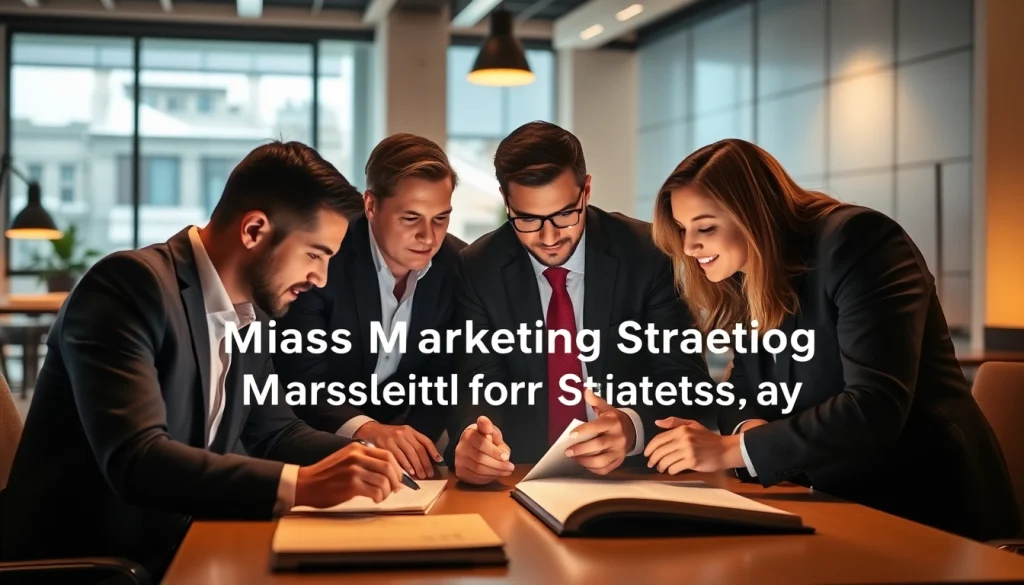
Understanding Mass Tort Marketing
Mass tort marketing is a specialized field within legal marketing, driven by the unique nature of mass tort cases. These cases often involve large groups of individuals who have suffered similar harm due to the actions of a single entity, such as a corporation or pharmaceutical company. As the landscape of legal cases evolves, so too does the necessity for a well-thought-out marketing strategy aimed at reaching potential clients effectively. Understanding this paradigm can significantly enhance outreach efforts and maximize participation in these cases. In essence, effective Mass Tort Marketing encompasses a variety of strategies tailored to the nuances of mass legal claims.
Defining Mass Tort Cases
A mass tort refers to a legal action where many plaintiffs claim similar injuries or damages resulting from a single product or event. This distinguishes it from a class action case, where plaintiffs are treated as a single entity. Mass torts can arise in various contexts, from consumer products like defective medical devices to environmental disasters. Notable examples include lawsuits against pharmaceutical companies for harmful medications or litigation surrounding environmental pollution affecting local communities. These cases are complex and typically require extensive documentation, clear evidence, and a robust legal strategy to navigate the process.
The Importance of Mass Tort Marketing
Mass tort marketing serves a critical function in informing potential clients about available legal options. It not only raises awareness regarding specific tort cases but also educates individuals on how they may have been impacted. Given the intricacies of mass tort cases, effective marketing is essential in driving participation, which is crucial for a successful case outcome. By employing targeted marketing strategies, law firms can ensure that they reach the right demographic, fostering a sense of community among the affected individuals and validating their experiences.
Who Can Benefit from Mass Tort Marketing?
Various stakeholders can benefit from mass tort marketing, including:
- Law Firms: Legal practitioners specializing in mass torts can enhance their client acquisition through targeted marketing strategies.
- Victims: Individuals affected by the same incident need to be made aware of their legal rights and the benefits of joining a mass tort case.
- Advocacy Groups: Organizations dedicated to consumer protection can collaborate with law firms to spread awareness and educate the public.
Key Components of a Mass Tort Marketing Strategy
Identifying Your Target Audience in Mass Tort Cases
In mass tort marketing, the first step is accurately identifying the target audience. This involves understanding the demographics, psychographics, and specific characteristics of the individuals affected by the mass tort. Tailored marketing efforts can then be developed based on this analysis, using data from consumer behavior studies, previous cases, and outreach effectiveness. Audience segmentation often includes factors such as age, geographic location, and background information relative to the case’s context.
Developing Compelling Marketing Messages
Creating a compelling marketing message is a vital component of a successful mass tort campaign. The message should resonate with potential clients’ emotions, emphasizing empathy, understanding, and the urgency of their situation. Personal stories and testimonials can be powerful tools in this regard, as they humanize the legal process and illustrate the real-world impact of the associated harm. Further, messages should clearly outline the benefits of joining the mass tort, addressing any fears or misconceptions about participating in legal action.
Utilizing Digital Platforms for Mass Tort Outreach
In today’s digital age, online platforms are essential for reaching potential clients effectively. Marketers can utilize social media, email campaigns, and legal websites to disseminate information about mass tort cases. Social media offers a unique opportunity for engagement, allowing for direct interaction with affected individuals and the sharing of crucial information. Moreover, optimizing content for SEO ensures that victims can easily find resources related to their specific concerns, thereby enhancing outreach efforts and driving engagement.
Best Practices for Executing Mass Tort Campaigns
Leveraging Social Media for Legal Marketing
Social media has revolutionized the way mass tort marketing is conducted, providing law firms with platforms to reach large audiences cost-effectively. By creating shareable content, engaging posts, and targeted advertisements, firms can effectively draw attention to mass tort cases. Regular updates and informative posts can help sustain interest and foster community among affected individuals. Campaigns leveraging hashtags related to the mass tort can also amplify reach and visibility online.
Creating Informative and Engaging Content
The cornerstone of an effective mass tort marketing strategy is the creation of high-quality, informative content. This includes blog posts, infographics, videos, and webinars that educate potential clients about their legal rights and options. Content should be geared towards solving the audience’s pain points while providing valuable insights into the legal process. Case studies highlighting successful outcomes can further bolster trust and encourage participation.
Building Relationships with Potential Clients
Establishing rapport with potential clients is essential in mass tort marketing. This can be achieved through personalized communication, providing direct lines of contact for inquiries, and offering free consultations. Building trust is paramount, as individuals affected by mass tort cases often find themselves in vulnerable positions. Transparent communication that keeps clients informed about the process and progress of their case is essential in cultivating long-term relationships.
Measuring Success in Mass Tort Marketing
Key Performance Indicators for Mass Tort Campaigns
To ascertain the effectiveness of mass tort marketing efforts, law firms should establish clear Key Performance Indicators (KPIs). These may include metrics such as the number of leads generated, conversion rates, client retention rates, and engagement levels on various platforms. Monitoring these indicators enables firms to assess the success of specific campaigns and adjust strategies accordingly to improve performance.
Tracking and Analyzing Marketing Data
Employing analytics tools to track marketing data is vital in understanding the impact of a mass tort campaign. Data such as website traffic, social media interactions, and email engagement rates provide valuable insights into audience behavior and campaign effectiveness. Firms can use this data to refine their targeting strategies, ensuring that marketing messages resonate with those most affected by a mass tort.
Adapting Strategies Based on Metrics
Flexibility is crucial in mass tort marketing, as adaptive strategies based on performance metrics can lead to enhanced results. Regular evaluations of campaign performance allow firms to pivot quickly in response to emerging trends or shifts in audience sentiment. For example, if a particular platform yields higher engagement, resources can be reallocated to amplify efforts on that channel. Continuous learning and adaptation are essential for sustained success in a rapidly evolving marketing landscape.
Future Trends in Mass Tort Marketing
Emerging Technologies and Marketing Innovations
The future of mass tort marketing lies in embracing emerging technologies that enhance outreach capabilities. Innovations such as virtual reality (VR) for case simulations, artificial intelligence for predictive analytics, and chatbots for immediate client interaction are set to redefine how law firms connect with potential clients. Staying updated on these technologies can position law firms at the forefront of mass tort marketing strategies.
The Role of AI in Legal Marketing
Artificial intelligence is becoming increasingly important in legal marketing, enabling firms to analyze large volumes of data quickly and efficiently. AI tools can help identify trends and predict outcomes in mass tort cases, allowing for more informed decision-making regarding marketing strategies. Additionally, AI can automate mundane tasks, freeing up resources to focus on relationship-building and high-value activities.
Preparing for Changes in Consumer Behavior
As consumer behavior evolves, law firms should anticipate and adapt to these changes. Factors such as increased digital engagement and growing expectations for personalized communication are likely to shape the future landscape of mass tort marketing. Understanding these shifts and integrating them into marketing strategies will be essential in maintaining relevance and achieving successful client outreach.






